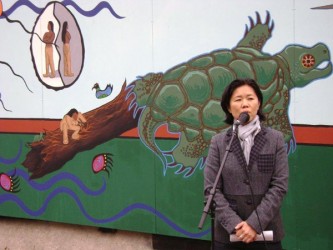Article Origin
Volume
Issue
Year
Toronto, with an Aboriginal population of more than 75,000, it is often called Canada’s largest reserve. However, there has never been anything that has proclaimed the presence of Aboriginal people in the city as loudly and as clearly as All My Relations, an art mural unveiled in Toronto’s Allan Gardens on Nov, 9. Allan Gardens is located in the heart of downtown.
Toronto City Councillor Kristyn Wong-Tam whose Ward includes Allan Gardens as well as the largest concentration of Aboriginal people in the city, said it’s about time the First People in Toronto had the opportunity to tell their story. First Peoples have such a distinct history in Canada and nothing comes close to what they have experienced, she told Windspeaker, and you can’t talk about the history of Toronto or the history of Canada without talking about the First Peoples and the contributions they’ve made.
All My Relations is an artwork of monumental proportions. The mural is the size of two football fields, more than 90 square metres. It’s been painted on construction hoarding that surrounds the Gerrard Watermain Replacement Project that is expected to take at least three years to complete. From the initial discussions about the concept to the unveiling, it took one year and more than artists to complete the mural.
The bulk of the painting was done during the hot summer months. Toronto experienced a record-breaking heat wave this past summer with temperatures climbing to the mid-30s. With the humidity added, it felt more like the mid-40s.
The heat wasn’t the only weather challenge. The impact of Hurricane Sandy was felt by the mural when high winds whipped through the park uprooting a nearby tree and tearing off about 20 boards. A call went out to the community and people quickly descended on Allan Gardens to repair the damage.
It was the memorial wall for the missing and murdered Aboriginal women that sustained the damage. The wall is located on the east side where, according to traditional teachings, all life begins. The painting, done predominantly in blue, with its vast expanses of water and sky depicts the moon teachings because of the special relationship women have with the moon. It portrays the beauty and power of Aboriginal women, and with its strong affirmation of all life, it is a fitting tribute to the murdered and missing women.
Nationally-recognized award winning artists Tannis Nielsen and Phillip Cote were the lead artists for the project. They say the mural has already brought out the best in neighbourhood residents and members of Toronto’s Aboriginal community. During the hot summer days, people brought food and cold drinks for the artists. More importantly, though, Nielsen said, they provided daily encouragement for the artists to keep at the task and see the project through to completion. New and positive relationships were formed and Nielsen says this can lead to an understanding that we are all related, we are all connected and we can come together in spite of our differences to create a renewed sense of community.
The themes of the other four paintings comprising the mural are dedicated to Community, Water, Anishnawbe Teachings and History of the Land. Lead artist Phillip Cote explains that the project’s Elders, Dorothy Peters and Alex Jacobs were crucial to the success of the art project. They shared traditional teachings and challenged the artists to root their vision for the mural in Indigenous values, beliefs and community structures.
In addition, Cote drew inspiration from the work of the late Norval Morrisseau, and from The Mishomis Book authored by Eddie Benton-Banai. Cote worked on the largest painting in the mural titled History of the Land which spans the distance from the beginning of time with the birth of the cosmos, the creation of Original Man, the first ceremonies, the renewal of the earth on the back of the turtle, and on until the current time. The colours are bright, the images well-executed and there is no doubt that this painting and in fact, the entire mural is Aboriginal story telling at its best.
The project was not without its challenges, Cote says, we became like a family and families do not always operate in a harmonious way. Tannis Nielsen concurs and says, it was only by sharing our blood, sweat and tears and a whole lot of love that we were able to work together as relatives and to achieve what we’ve done. Other challenges had to do with relying on multiple sources of funding, says Nielsen, and delays in receiving funds.
A project like this one is vital to our First Nations community locally and nationally, says Cote, in explaining what motivated him to get involved. It represents a reflection of a great past, but more importantly, it represents the future and cultural identity for our youth today, he says.
- 5762 views

